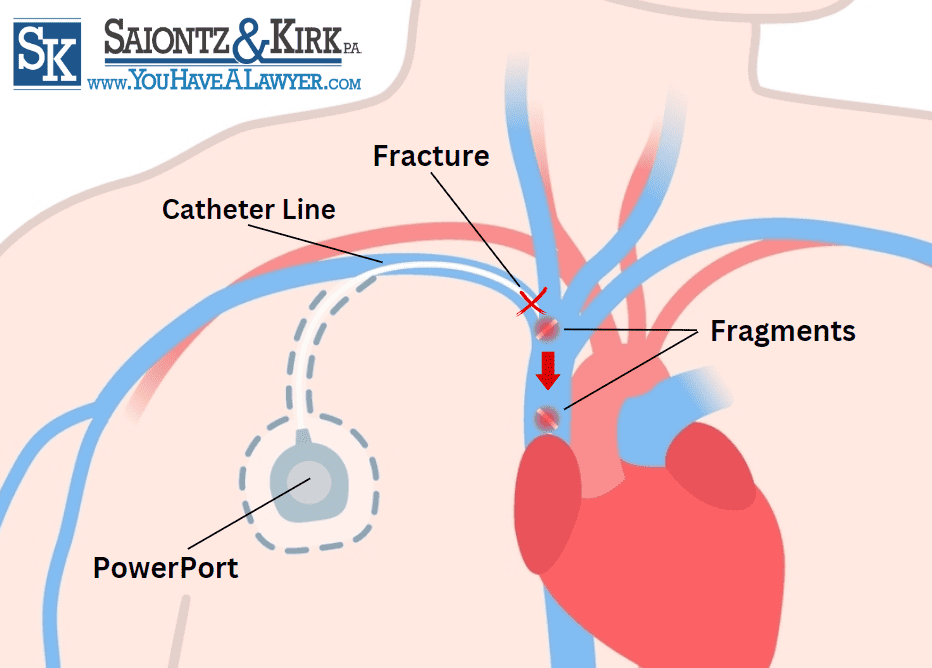Bard PowerPort Lawsuits Over Catheter Fractures & Migration
The Bard PowerPort is a type of port catheter device implanted to provide long-term access to a peripheral vein to administer medications or fluids. However, design defects may weaken the strength of the implantable flexible catheter tubing, leading to a serious risk that the Bard PowerPort may fracture, migrate, leak or fail.
Our lawyers represent individuals throughout the U.S. who are now investigating Bard PowerPort Lawsuits against Becton Dickinson and its subsidiary, claiming that the manufacturers knew about the risk of Bard PowerPort devices fracturing and migrating, yet failed to take any steps to correct the problems or warn the medical community or patients.
Bard PowerPort fracture lawsuits and settlements are being pursued for individuals who received a Bard port catheter implantable venous access system and developed any of the following complications:
- Perforations of tissues, vessels and organs
- Infections (sepsis or septic shock)
- Deep Vein Thrombosis (DVT)
- Hemorrhaging or Bleeding Injuries
- Fluid buildup on the heart
- Irregular Heartbeat
- Severe and persistent pain
- Chemotherapy leaking into the body
- Wrongful death
- Other injuries caused by fractured PowerPort catheter
If you or a loved one have experienced problems caused by a Bard PowerPort fracture, contact our port catheter injury lawyers for a free consultation to see if you may be eligible for a PowerPort lawsuit settlement.
Info About Bard Port Catheter Fractures On This Page
Why Does a Bard PowerPort Fracture?
Types of Bard PowerPort Failures Leading to Lawsuits
Bard PowerPort Catheter Fracture Lawsuit
Bard Chemo Port Leak Lawsuit
Bard PowerPort Catheter Migration Lawsuit
Who is Responsible for my Bard PowerPort Injury?
How a Bard PowerPort Injury Lawyer Can Help
Why Does a Bard PowerPort Fracture or Fail?
Bard PowerPort lawsuits allege that a PowerPort can fracture due to the high concentrations of barium sulfate used in the chemical makeup of the Chronoflex catheters, which have been found to weaken the integrity of the polyurethane tubing.
Bard access systems have become a widely adopted port-a-cath product across different healthcare settings and specialties, including oncology, hematology, and pediatrics, since the devices are power injectable, allowing the administration of fluids at high rates of flow for imaging studies such as CT scans.
The PowerPort often features a Chronoflex catheter, which is highly visible during radiologic scans and allows healthcare providers to visualize the catheter’s position, trajectory, and any potential complications or issues related to its placement or function. However, it now appears that the design of the PowerPort catheter may increase the risk of fractures developing.
The high visibility of the catheters is achieved by using a polyurethane mixture that includes concentrations of barium sulfate, called Chronoflex, which is supplied by AdvanSource Biomaterials Corporation. The barium sulfate acts as a radiopaque substance to enhance the visibility of the catheters during the scans.
Bard PowerPort lawsuit allegations indicate that the barium sulfate used in the Bard PowerPort catheters dissolves from the surface of the catheter, leading to the development of small fractures and fissure in the tubing. Over time, these fractures in the catheters weaken the catheter’s strength, and ability to withstand power-injection flow rates.
Types of Bard PowerPort Failures Leading to Lawsuits
The Bard PowerPort device is connected to the central veins of a patient’s circulatory system. The port is typically placed directly under the patient’s skin in the chest or arm, and is connected to a small, soft tube called a catheter, which is inserted into one of the large central veins that lead to the heart.
Due to central venous catheter insertion in a large central vein that leads to the heart, a defective Bard PowerPort device failure can cause significant internal damage. If the injection port catheter tubing fractures, it could lead to blockages or punctures of critical veins leading to the heart. Additionally, catheter fragments from the broken tubing could reach the heart, leading to potential cardiac problems and even heart failure.
Lawsuits have been filed over three specific types of PowerPort malfunctions and failures that result in serious injuries, including:
- Bard Port Catheter Fractures
- Bard Port Catheter Leaks
- Bard Port Catheter Migrations
Bard PowerPort Catheter Fracture Lawsuit
As a fracture or fissure develops on the surface and body of the catheters, the device may become more prone to breaking away while undergoing power injections. After time, fragments of the catheter may break off and travel through the bloodstream to vital organs.

A PowerPort catheter fracture may lead to various side effects including,
Heart Damage
When an Bard PowerPort catheter device breaks off in a central vein, it can cause trauma or damage to the double-layered sac that surrounds the heart, known as the pericardium. This can trigger an inflammatory response resulting in fluid build-up around the heart.
The fluid build up on the heart can lead to;
- Excessive pressure on the heart
- Impaired function of the heart
- Fluid backing up into the lungs
- Liver and Kidney dysfunction
- Increased risk of cardiac failure
- Irregular Heart Beat (Arrhythmia)
Irregular Heart Beat (Arrhythmia)
When a catheter breaks, it can potentially disrupt the heart’s electrical system. The broken catheter fragment may irritate or damage the heart tissue, causing abnormalities in the conduction of electrical signals. This disruption can interfere with the normal sequence of electrical impulses and lead to an irregular heartbeat.
Deep Vein Thrombosis (DVT)
The presence of a broken catheter in the veins can increase the risk of deep vein thrombosis (DVT), which is the formation of blood clots. When a blood clot forms in the deep veins, it can partially or completely block the blood flow through the vein, leading to various symptoms.
Common signs and symptoms of DVT include leg pain, swelling, warmth, and redness.

Pulmonary Embolism
When a PowerPort catheter fractures, it can allow pieces to detach and enter the bloodstream resulting in an embolism. The broken catheter pieces can block blood vessels, resulting in reduced or blocked blood flow to the affected organ or tissue. The severity of the embolism depends on the size and location of the detached piece.
If the fragment breaks free from the clot and travels to a pulmonary artery in the lungs, it can cause a condition known as pulmonary embolism.
Pulmonary embolism occurs when a blood clot or foreign material obstructs the arteries in the lungs, leading to a sudden blockage of blood flow. This can impair oxygenation and may result in various symptoms, such as chest pain, shortness of breath, rapid breathing, coughing, and in severe cases, can be life-threatening.

Hemorrhaging or Bleeding Injuries
Catheter fractures may cause harm to the vein or adjacent structures, resulting in bleeding, hematoma formation, or other vascular damage. Surgical intervention may be necessary to repair the damaged vessels or retrieve the broken fragment.
PowerPort Infection
A broken PowerPort catheter can also serve as a breeding place for infection. Bacterial colonization or biofilm formation on the fragment may lead to local or systemic infections, such as catheter-related bloodstream infections (CRBSIs) or sepsis. Surgical removal and antibiotic treatments are typically required to manage injuries arising from a catheter infection.
Bard Chemo Port Leak Lawsuit
The PowerPort is frequently used in cancer patients to receive high pressure injections of chemotherapy agents, which are designed to be cytotoxic, meaning they kill or halt the proliferation of cells. When chemotherapy drugs are introduced directly into the bloodstream, they can target cancer cells throughout the body.
However, a number of Bard PowerPort leak lawsuits have been filed by individuals who experienced injuries when the defective catheter allowed harsh chemotherapy drugs to leak from the cracks into the surrounding tissue, rather than being correctly channeled into the larger central veins.
What happens if the Bard chemo port leaks?
When the Bard PowerPort fractures it no longer functions as a closed system and can allow chemotherapy medications to escape through cracks and cause damage to nearby tissue. This is a condition known as extravasation, which is the unintentional leakage of fluids or medications from the vein into the surrounding tissue.
When a Bard PowerPort leaks chemotherapy medication into surround tissues it can cause a wide range of injuries, including;
Tissue Damage
The potent chemicals can damage healthy tissues, potentially causing cell death, which may result in permanent scars, decreased functionality in the affected region, and continuous pain.
Extravasation Injury
This is when medication intended for intravenous administration spills into surrounding tissue. Severe extravasation can result in tissue necrosis, requiring surgical intervention and leading to permanent damage.
Nerve Damage/Loss of Mobility
If not treated promptly, the PowerPort leak can result in long-term complications like nerve damage, muscle atrophy, and loss of limb function, depending on the affected area.
Sepsis/Infections
A fractured and leaking PowerPort can create a pathway for bacteria and other pathogens to enter the bloodstream, leading to serious and potentially life-threatening infections.
Symptoms of a Bard chemo port leak
The most commonly reported symptoms of a Bard chemo port leak include;
- Local Swelling and Redness: One of the earliest signs might be swelling or redness at the site where the PowerPort is implanted.
- Pain or Burning Sensation: As the chemotherapy medication comes into contact with tissues, it can produce a burning sensation or cause pain.
- Limited Mobility: If the leak affects muscles or nerves, it might lead to reduced mobility in the nearby areas.
- Blistering or Skin Discoloration: In severe cases, the skin above the leaked area might start showing blisters or change color due to the toxicity of the chemotherapy agents.
- Fever or Other Signs of Infection: Symptoms like fever, chills, or increased pain at the site could indicate a possible infection due to the PowerPort’s malfunction.
Bard PowerPort Catheter Migration Lawsuit
Catheter migrations are a less frequent complication from a Bard PowerPort failure, but can pose serious health risks. A PowerPort migration occurs when the catheter detaches itself from the device and travels to organs within the body’s circulatory system.
Due to the placement of the PowerPort central venous catheters, a migration can cause the device to reach the heart, requiring immediate surgery and extraction to prevent life-threatening complications.
While a catheter migration can be the result of a physician’s placement error, many Bard PowerPort lawsuits claim the catheter migrated due to design defects, even in the absence of a medical mistake.
What are the symptoms of port catheter migration?
Symptoms of a Bard PowerPort catheter migration can vary depending on the implant site and which central vein is used. Some of the potential symptoms of a PowerPort migration may include;
Pain or Discomfort
Individuals may experience localized pain or discomfort at the site of the migrated catheter or along the pathway of migration. This can include pain in the neck, shoulder, or ear.
Catheter Dysfunction
Migration of the catheter can lead to functional impairment, resulting in difficulty or inability to deliver chemotherapy or other medications effectively. This may manifest as inadequate flow or inability to draw blood from the port.
Swelling or Edema
In some cases, migration of the catheter may cause swelling or edema at the site of migration or in the surrounding areas.
Can a power port move?
Yes. Bard PowerPort implantable ports have the potential to move from their intended position. Although the PowerPort is designed to remain securely tied into the internal jugular vein or subclavian vein, there are instances where it may shift or migrate. Factors that may contribute to a PowerPort moving include;
- Defective design
- Patient movement
- Trauma
- Improper placement
Who is Responsible for my Bard PowerPort Injury?
Responsibility for many reported Bard PowerPort injuries lies with the medical device manufacturer, Becton Dickinson and its subsidiary C.R. Bard. Lawsuits allege that many fracture and migration complications associated with the Bard PowerPort could have been avoided if the manufacturer had thoroughly researched and tested the design of the implantable port device.
Given the growing number of Bard PowerPort lawsuits being filed across the U.S., each raising similar allegations that the port catheter devices are defective, unreasonably dangerous, and that the manufacturers failed to warn about the risks and complications associated with the implants, a Bard PowerPort MDL (multidistrict litigation) was formed in May 2023.
These lawsuits seek compensation for the injuries, medical expenses, pain and suffering, and other damages caused by the Bard implanted port device.
What To Do After A Bard PowerPort Device Failure?
If you suspect your port catheter has fractured you should seek medical help immediately. As we have discussed above, a fractured PowerPort catheter can lead to severe and life threatening injuries that require immediate medical attention.
Once you have received treatment for your injuries, the next step is to contact Saiontz & Kirk, P.A. for a free consultation. Our experienced product liability lawyers will go over the details of your case to determine whether you may be eligible for a Bard PowerPort lawsuit settlement.
How a Bard PowerPort Lawyer Can Help
The medical device manufacturers of the Bard PowerPort have been blaming patient injuries on physicians for years, and are likely to defend their products’ design and integrity. Going against medical device manufacturers alone could be challenging and costly if mistakes are made.
At Saiontz & Kirk, P.A., our team of expert product liability lawyers have the experience and resources needed to hold these manufacturers accountable for the harm they have caused you or your loved one.
How to file a Bard PowerPort Lawsuit: Find out if you or a loved one qualify for a Bard PowerPort lawsuit settlement. Fill out the form to schedule a case review or call our Bard PowerPort lawyers today at 800-522-0102 for a free consultation.
We operate on a contingency fee basis, meaning you do not pay a penny unless we win your case. Let us fight for your rights and seek the compensation you deserve.
